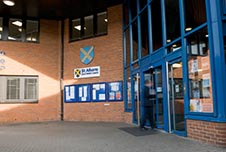
Emissions target success
A key target for reducing harmful carbon dioxide (CO2) emissions in the St Albans District has been met, recently published figures show.
St Albans City and District Council has been committed to cutting emissions across the District by 3% a year since 2006 to achieve a 60% reduction by 2025.
The Department of Business, Energy and Industrial Strategy has now released statistics for 2016 which show a reduction of 6% on the year before – double the target figure.
Since 2006, emissions have dropped by 28% - well within the 3% a year mark – with CO2 generation down from 809 kilotonnes to 585 in 2016.
On a per person basis – which takes into account a rise in population – emissions have been cut by 35% over that period.
One target that was not met was a 1.5% annual reduction from 2010 in emissions from domestic energy use.
This figure is 21 kilotonnes higher than the target largely because of the cold winters of 2012 and 2013 which led to more energy use for heating.
Emissions of greenhouse gases are seen as a major cause of global warming.
The Council does not control the amount of emissions across the District, but encourages householders, motorists and businesses to take action to help reduce them.
An update on the latest figures is to be given to a meeting of the Council’s Cabinet on Thursday 20 September.
Nationally, emissions from energy supplies have decreased due to a change in the fuel mix for electricity generation. This includes less use of coal and more use of gas, and renewables.
Transport emissions District-wide are 5% lower than 2006 largely due to improvements in vehicle efficiency, though the actual distance travelled has increased.
The Council has a target of reducing its own greenhouse gas emissions by 20% of 2008/09 levels by 2020/21 – the equivalent of annual reductions of 1.8%.
Figures for 2017/18 show that the overall target has almost been reached already with emissions having been cut by 19%.
Emissions from Council-owned buildings have halved since 2008/09 as have emissions from Council vehicles and business travel.
Among the actions taken by the Council are the use of energy-efficient LED lighting at its offices and the installation of solar panels as part of the energy-efficient design of leisure centres.
Secondary glazing, under-floor heating and LED lighting were installed at the new Museum + Gallery which opened this year.
To help reduce District-wide emissions, the Council has a programme of installing energy-efficient boilers, windows and doors at many of the 4,800 homes that it owns.
The Council also supports the Sustainable St Albans Week which this year involved 120 groups running 91 events, highlighting a range of issues including energy conservation. It is estimated that 10,000 people were reached through the events.
Councillor Frances Leonard, Portfolio Holder for the Environment, said:
Reducing CO2 emissions is a very important task and much work has gone into achieving this objective.
In practice, this means reducing energy wastage by switching off lighting and equipment when we’re not using them, recycling more or travelling by car and plane less.
I’m pleased that we have met our main target of cutting the District’s overall emissions by 3% a year.
We have been taking measures to cut emissions from our own buildings and vehicles, and will explore all other opportunities to reduce unnecessary consumption. We need businesses and householders across the District to get involved and they are responding positively to the challenge.
That is illustrated by the success of Sustainable St Albans Week, an event that has grown substantially in recent years with the number of people it has influenced, rising all the time.
Councillor contact:
Cllr Frances Leonard, Environmental Portfolio Holder for St Albans City and District Council
Tel: 01727 861860, Email: cllr.f.leonard@stalbans.gov.uk
Contact for the media:
John McJannet, Principal Communications Officer, St Albans City & District Council
Tel: 01727 296130, E-mail: john.mcjannet@stalbans.gov.uk
